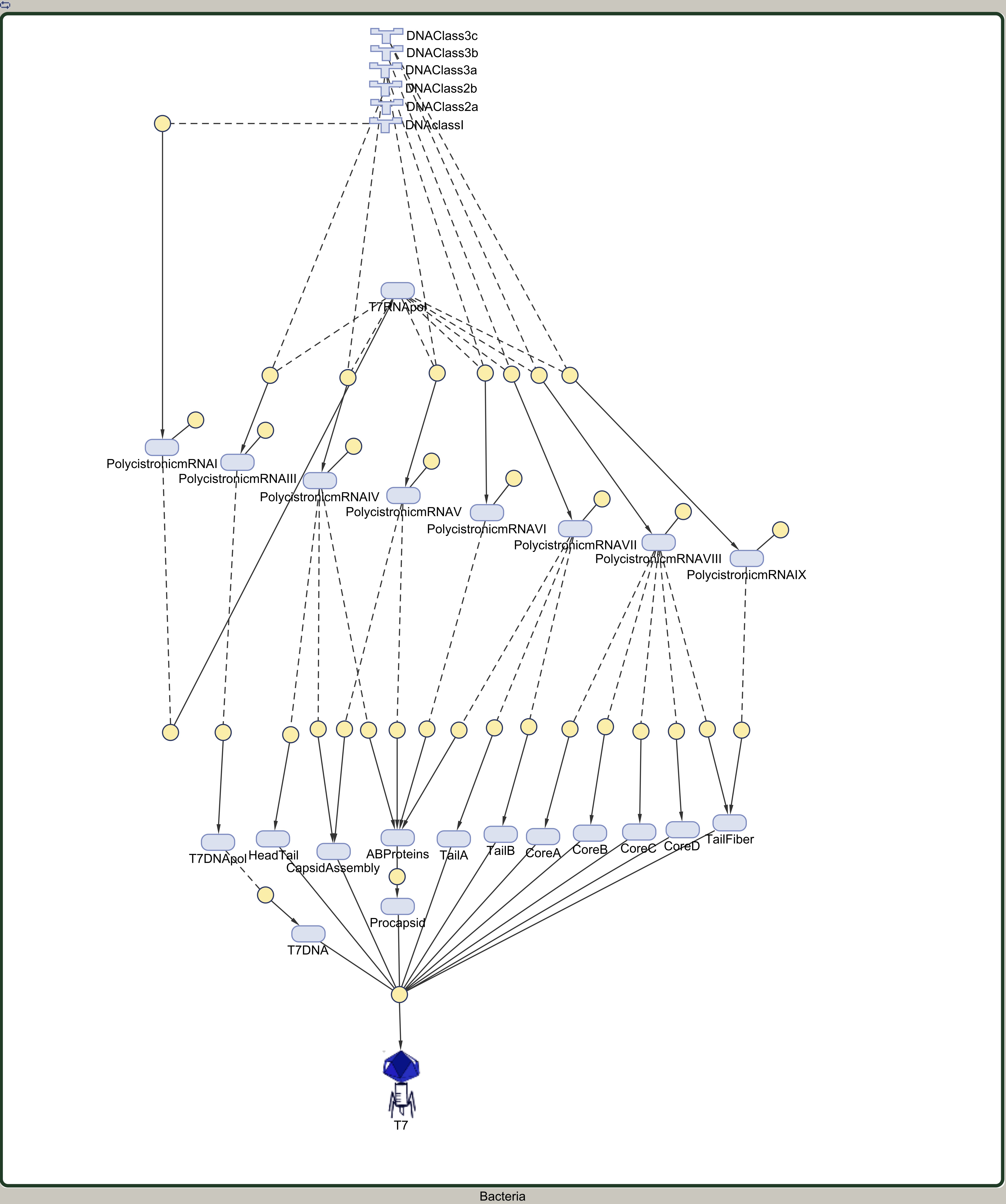Team:LCG-UNAM-Mexico:WTM
From 2009.igem.org
(→WILD-TYPE MOLECULAR MODEL) |
(→WILD-TYPE MOLECULAR MODEL) |
||
| Line 10: | Line 10: | ||
The following critical processes are accounted in this model: | The following critical processes are accounted in this model: | ||
<br> | <br> | ||
| - | * <h2>Insertion and translocation of | + | * <h2>Insertion and translocation of T7 DNA at different times</h2> |
<br>Entry of T7 DNA into the host cell occurs in several distinct stages. | <br>Entry of T7 DNA into the host cell occurs in several distinct stages. | ||
<br>Phage's DNA is arranged in three classes of genes depending on their positions, it is translocated into the cell between 6 to 10 minutes after attachment, so this order and timing drives the phage's development. This phenomenon of DNA translocation is modeled here taking into account reported insertion speeds [REFERENCE]. | <br>Phage's DNA is arranged in three classes of genes depending on their positions, it is translocated into the cell between 6 to 10 minutes after attachment, so this order and timing drives the phage's development. This phenomenon of DNA translocation is modeled here taking into account reported insertion speeds [REFERENCE]. | ||
Revision as of 03:55, 18 October 2009
WILD-TYPE MOLECULAR MODEL
WTM is a stochastic molecular model of bacteriophage T7 life cycle, it was constructed to simulate wild-type development of this phage in E Coli.
The following critical processes are accounted in this model:
-
Insertion and translocation of T7 DNA at different times
Entry of T7 DNA into the host cell occurs in several distinct stages.
Phage's DNA is arranged in three classes of genes depending on their positions, it is translocated into the cell between 6 to 10 minutes after attachment, so this order and timing drives the phage's development. This phenomenon of DNA translocation is modeled here taking into account reported insertion speeds [REFERENCE].
-
Transcription of different T7 DNA segments into polycistronic mRNAs
It has been shown that T7 genes are expressed in overlapped polycistronic mRNAs.
Transcription of T7 polycistronic mRNAs occurs if and only if its coding DNA segment is available in the cell. Transcription is dependent of the set of genes inserted at a time.
We define a set of transcription rates for every polycistronic mRNA taking into account constant bacterial or T7 RNA polymerase elongation rates and the length of the polycistronic mRNA, these transcription rates will be our rate limiting steps at the transcriptional level.
-
Degradation of phage mRNAs
We assume the same degradation rate for all T7 polycistronic mRNAs. Until now impact of this phenomenon had not been studied. It has been found that phage messengers are stabler than Bacterial mRNAs [REFERENCE].
-
Translation of phage mRNAs into proteins
In this model, translation is simulated assuming an environment of unlimited amino acids and ribosomes. We also assume that the rate at which ribosomes incorporate amino acids is constant over all T7 mRNA.
As it has been done for transcription we define a set of translation rates for every protein taking into account a constant ribosome elongation rate and the length of the protein, these translation rates will be our rate limiting steps at the translational level.
-
T7 DNA replication
DNA synthesis is simulated by taking elongation of T7 DNA polymerase as the rate-limiting step.
We assume an environment of limited free nucleotides so we can set a maximum number of T7 genomes produced in a single infection taking into account the size of the host genome (and this includes bacterial chromosomes, plasmids and other sources of free nucleotides).
-
Procapsid Assembly
This phenomenon is simulated in almost the same way as Drew Endy et al. 1996 using mass action kinetics.
-
DNA packaging and final assembly
Both processes are modeled using mass action kinetics as well. This last step requires complete procapsids, T7 DNA, and enough of each structural protein to complete the phage. The simulation assumes that packaging of DNA into the procapsid is the rate-limiting step for T7 progeny formation.
References
 |  |  |
|---|
 "
"




